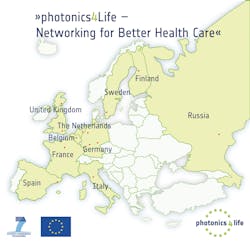BIOPHOTONICS R & D/DISEASE DIAGNOSIS & THERAPY: European Union rethinks research funding
Like optical communications did in the 1990s, biophotonics technology is poised to lead an economic revolution based on light. Several factors are converging to usher in this new wave. For one, biophotonics has moved into clinical use. After spending a decade or two in the research lab, biophotonics systems are becoming integral tools for disease diagnosis and therapy. In addition, the world population continues to grey. By 2030, one in eight people worldwide will be aged 65 or older. That works out to one billion people across the globe. To provide healthcare to this aging population, world governments need solutions that are inexpensive, user-friendly and highly portable.
In Europe, where nearly 30% of the population will be 65 or older in 2050, the European Union (EU) is backing biophotonics as a key driver in its economic and healthcare plans. A strategic plan developed by Photonics21, an industry-driven consortium that advises the EU, outlines how breakthroughs in biophotonics techniques and devices can power the European economy, as well as addresses critical healthcare issues facing an aging population. The group has identified four areas where photonics technologies can make a difference: cancer diagnosis and therapy, eye-related diseases, sepsis (a blood infection), and pre-clinical research.
International initiative: Photonics4Life
Beginning with the 2007-2013 budget cycle, the EU showed its support of biophotonics by funding a number of efforts aimed at coordinating biophotonics research activities throughout the EU. One of the key projects is the Photonics4Life Network of Excellence. To push European biophotonics to the next level, Photonics4Life (P4L) proposed building a framework to integrate biophotonics research across Europe.
"This particular instrument brings together research groups in a field that is highly fragmented in order to provide a coherent framework," says Juergen Popp, coordinatior of the P4L network and scientific director of the Institute of Photonic Technology, Friedrich Schiller University Jena. "We want to break down barriers between different disciplines in biophotonics to improve the connection between [physicists and engineers] and biomedical end-users such as physicians and biologists."
Through its consortium partnering programs, P4L is creating ways to link disciplines and research related to biophotonics. Among the programs that create cross-fertilization between different partners are a minimally invasive clinical test based on in-vivo, hyperspectral lifetime measurements of autofluorescence to diagnose basal cell carcinomas, and photonic control of nanocontainers to investigate interactions with cells. The second round of competition gave preference to interdisciplinary projects that link different disciplines in biophotonics and the projects received funding in June of this year.
To help its partners make connections with each other, P4L is setting up ways to share their findings, cross-link between fields, engage industry, and disseminate information to the general public to show the benefit of optical technologies for healthcare. One critical component of the effort is the Biophotonics Database, which contains information on existing photonics methods and techniques and links them with biological processes and/or clinical needs such as disease diagnosis.
The network is also engaging industry through its Industrial User Club. A little over a year old, the club has 14 members and is slowly expanding its program offerings, which currently include information on starting a small business.
Complementary national programs
Programs such as P4L on the European level complement ongoing activities on the national level. Germany, Ireland, Scotland and the Netherlands are leading the way with efforts dedicated to supporting biophotonics. Germany has invested approximately €100 million ($131 million) in biophotonics since 2002, the Netherlands biophotonics program has a €25 million ($33 million) budget, and Scotland has provided about £14 million ($22 million) in research grants since 2005.
In the case of Ireland, the National Biophotonics and Imaging Platform of Ireland (NBIP) was established by the Higher Education Authority of Ireland with a grant of €30 million ($39 million) in 2007. The NBIP is a consortium of imaging and biophotonics laboratories from universities and technology institutes in Ireland, France, Italy, Finland, Denmark, Norway and Sweden.
"NBIP Ireland's goal is to harness the exchequer, EU and private investments in biophotonics and imaging research centers into a single network of sufficient critical mass to provide state-of-the-art technology cores for advanced research and training, competitiveness in large-scale funding programs, and to attract industry collaborations, particularly in beta-testing sites of new imaging devices and reagents for medical and surgical 'discovery' applications," says Eadaion McKiernan, programs manager, NBIP Ireland Research Office.
McKiernan says that collaboration is the key to success of the platform. To help achieve this goal, NBIP has developed a memorandum of understanding between NBIP partners that includes a set of non-binding intellectual property principles, under which IP generated by the NBIP Ireland is owned, managed, and commercialized.
About 102 investigators have participated in NBIP-supported projects since 2007. Some of the projects have involved the molecular genesis of cancer, diagnostic tools for vascular disease, automated live cell analysis, and optical imaging techniques to assess microcirculation and skin aging.
While NBIP is focused on sustaining biophotonics research, the platform also wants to reach out to industry. "Of particular importance is the development of links with industry, a number of which have been established through sponsorship initiatives, joint research projects and commercialization of research and technologies," McKiernan says.
NBIP is also committed to creating training programs for graduate and post-doctoral students to meet the needs of industry. One program enables post-docs to participate in collaborative research with public and private sector organizations both within Ireland and throughout the EU.
P4L and the NBIP are just two examples of the new approach the EU is taking to coordinate and support biophotonics research. The EU is betting on this new course to position Europe as the "Innovation Union" by 2020. Biophotonics will play an important role in delivering on that moniker.
About the Author

